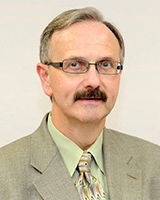Mental Health Needs of Hospital Workforce
By Jena Pierce on
The COVID-19 pandemic has disrupted lives and impacted everyone across the globe for over two years. The mental health concerns for the general public has increased, but what has the pandemic done to the mental well-being of healthcare workforce? A new study set out to determine the impact on hospital workforce and to see if there was a difference between rural and urban environments.
A Partnership

Dan Kelly was the CEO of McKenzie County Healthcare System in Watford City, North Dakota. He led his organization through the first wave of COVID-19 in his rural community of 6,200 people, with his staff serving a county of 14,700 people. Kelly retired from his position in 2022.
"Early in the pandemic," said Kelly, "there were some studies coming out of other countries about workforce, but they only looked at physicians and nurses, and nothing was coming out of the U.S. We wanted to look at all healthcare workers within the state of North Dakota and we wanted to understand what the impact was going to be in a rural community, versus urban."

Kelly reached out to Brad Gibbens, acting director of the Center for Rural Health (CRH) at the University of North Dakota School of Medicine & Health Sciences (UND SMHS). Kelly knew CRH had experience conducting research studies and could provide assistance with this interest area.

Gibbens put Kelly in touch with Dr. Shawnda Schroeder*, who at the time was the associate director of research and evaluation at CRH and was a trainer with the Mountain Plains Mental Health Technology Transfer Center (MHTTC) (no longer available online), and Kristen Leighton, a research analyst at CRH. They rounded out the research team with Mandi-Leigh Peterson, a senior research analyst with CRH. Leighton and Peterson are part of the North Dakota Healthcare Workforce Group within SMHS.
The Study
The study was geared to assess the levels of anxiety, depression, stress, and professional quality of life among all hospital staff in North Dakota during the COVID-19 pandemic.
Before the pandemic, healthcare workforce had a history of dealing with depression and anxiety. Kelly was curious how the added stress of the public health crisis impacted an already stressed workforce.
It makes perfect sense that we have individuals that are saying they are starting to experience burnout, stress, depression, anxiety.
"I think what made this of interest," said Kelly, "is this particular pandemic brought its own set of stressors in a very precise period of time. At first, the healthcare workers were the heroes. We were getting accolades. Then, societally, we were turned against. We were shunned and ridiculed. We were working short staffed, we didn't have proper supplies, initially there was no vaccine, and we did not know what tomorrow would bring."
Kelly continued, "Then add to all of that the reality that you may incur this illness yourself, or worse, bring it home to your family. It makes perfect sense that we have individuals that are saying they are starting to experience burnout, stress, depression, anxiety."
The study was conducted in May and June of 2021, after the initial wave of COVID-19 throughout North Dakota. Over 800 people responded to the survey.
Within a hospital, everyone plays an important role and everyone has felt the effects of COVID-19, so it's important to include all those voices.
"I think what really sets our study apart," said Leighton, "is that we chose to include not just physicians and nursing staff, but really everybody involved in the hospital system. Within a hospital, everyone plays an important role and everyone has felt the effects of COVID-19, so it's important to include all those voices."
Measurement Instruments
The areas of anxiety, stress, depression, and professional quality of life were examined. Each area was chosen for two reasons: these were the areas being examined by other researchers in the international arena and they can be measured utilizing clinically validated instruments. The tools included:
- Anxiety: Generalized Anxiety Disorder 7-Item Scale (GAD-7)
- Depression: Patient Health Questionnaire (PHQ-9)
- Stress: Perceived Stress Scale (PSS)
- Professional Quality of Life (ProQOL)
Schroeder said, "These are some of the most commonly recognized tools for assessing mental health and wellness that are publicly accessible, and the first three are clinically validated tools. The ProQOL is not the most common for mental health diagnoses but is common for measuring quality of life in your profession."
Kelly explained, "The ProQOL is a survey instrument that really demonstrates the impact working in the healthcare field has on the healthcare workforce, and that looked at three components: compassion satisfaction, secondary traumatic stress (often termed 'compassion fatigue'), and burnout."
The Data
"Our sample size was really great," said Leighton. "I really appreciate those healthcare workers who took the time to respond to our survey. Having a large sample size is really important in research. It helps to ensure that the results are generalizable and applicable to the most amount of people."

Most respondents were women, and most were between 25-56 years of age. Many were nursing staff and other direct care staff. The general findings show the hospital staff who had direct contact with COVID-19 patients had higher levels of anxiety, depression, and stress than those without direct contact. However, staff in rural areas demonstrated higher levels of compassion satisfaction and lower levels of burnout than their counterparts in urban hospitals.
The study did not answer "why" there are differences between rural and urban staff compassion satisfaction and burnout, but the team believes this difference exists because of rural staff are caring for their community, people they know, and that fact becomes a protective measure.
Kelly shared, "There is much more of a cohort in rural healthcare. We don't have 200 physicians on our staff. Our employees know our providers and likewise. We only have 200 employees total, so there is more of a sense of support that comes from a family. You are going to church with these folks, you are to the store with them. There is more the sense of togetherness in a rural facility you likely can't get in a larger urban facility."
Healthy Coping Mechanisms
"The data tell us how healthcare workers have been impacted by COVID-19, but what I think is more interesting is the idea that our results can be instrumental in providing support for our healthcare workers and their mental wellness," said Leighton.
It is vitally important that individuals work to find healthy ways to cope, but also as important is having the healthcare organizations provide support and show employees that they are appreciated and valued.
"At an organizational level, promote the reality that the workers are providing a valuable service," Kelly said. "This can be done through announcements during the day, sending an email, demonstrate you care for your workers. Buy them food. If you can show you are supportive of your workers, that helps to offset some of the stress and anxiety that occurs."
The Mountain Plains MHTTC created a toolkit specifically to address these issues: Building Resilience Among Physical and Behavioral Healthcare Providers During a Global Health Pandemic (no longer available online). It provided some system level and individual recommendations.
Schroeder said, "The toolkit was developed under the premise that there is likely burnout and fatigue and stress being experienced by providers, but it did not have definitive research to make those connections. After completing this study, we know coping mechanisms can only start at the individual level if at first the system is supporting them and allowing staff the time and space to engage in self-care."
Published Study
An article on the study was published in the Journal of Rural Health in April 2022. Titled Anxiety, Depression, Stress, Burnout, and Professional Quality of Life Among the Hospital Workforce During a Global Health Pandemic, the article is available for public access.
"Without the Center for Rural Health and the Mountain Plains MHTTC covering the open access fee," said Schroeder, "it would not have the community response that it should. Because of this, the article is accessible to rural providers, hospital CEOs, and the community free of charge."
Schroeder continued, "Hospitals need these studies to make data-driven decisions, and it is not feasible to require them to pay to access journal articles to provide better care. Now all of the hospital staff who participated in the survey, all of the hospital CEOs in the state, and all of the hospital workforce can access this with no cost barrier, no paywall, and they can read it and see what the results were."
Rallying Support
A collective cry can be heard in rural communities. Healthcare workforce needs support. Support from each other, support from healthcare organizations, and support from the community. The mental health stresses will continue, along with a continued shortage in workforce.
"We are recommending finding ways the health system itself can support the workforce.
"We are recommending finding ways the health system itself can support the workforce," said Schroeder. "Find ways the community can support the workforce. This can be a strong rallying factor in rural areas as well."
Sharing the Study
Invitations to share the study at conferences and with different organizations have been received. The North Dakota Rural Health Association is helping to send Kelly and Schroeder to New Mexico to present at the National Rural Health Association's Annual Rural Health Conference in May.
They will also present at the Dakota Conference of Rural and Public Health in June in Grand Forks, along with several other opportunities to share what they have learned through this study.
*Dr. Shawnda Schroeder is currently an assistant professor in the Department of Indigenous Health at UND SMHS.


 is the communications manager at the Center for Rural
Health at the University of North Dakota School of
Medicine & Health Sciences in Grand Forks.
is the communications manager at the Center for Rural
Health at the University of North Dakota School of
Medicine & Health Sciences in Grand Forks.



